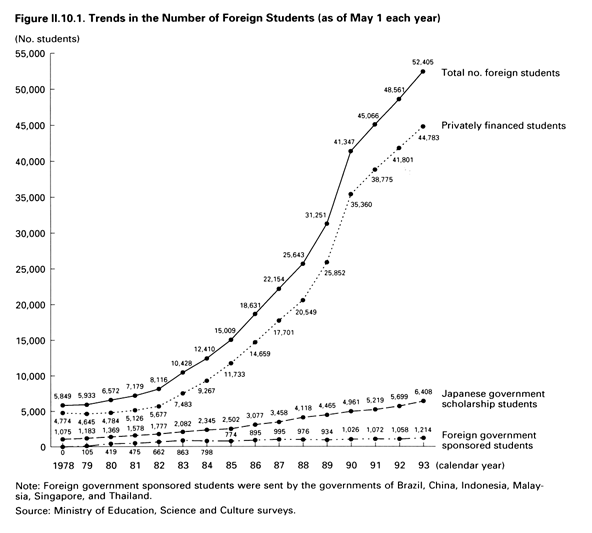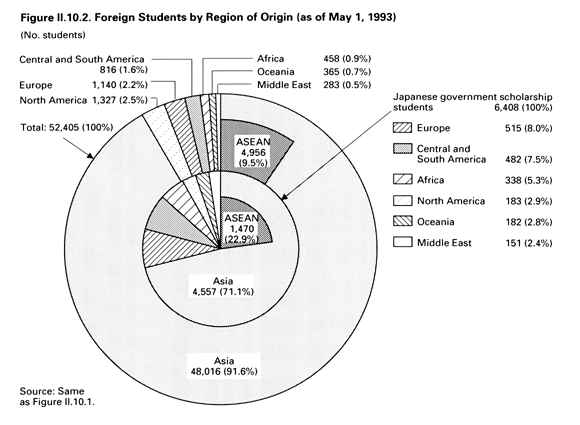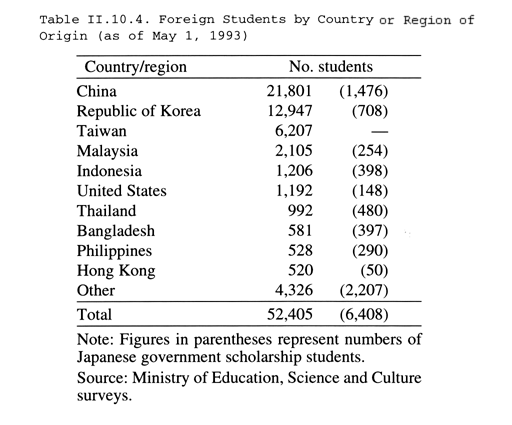| Home > Policy > White Paper, Notice, Announcement > White Paper > JAPANESE GOVERMENT POLICICIES IN EDUCATION, SCIENCE AND CULTURE 1994 > PART II Chapter 10 Section 4 1 | ||
Student exchange raises educational and research standards in Japan and other countries and helps foster the spirit of international understanding and cooperation. Such activities are also extremely important to human resource development in many countries.
The number of foreign students in Japan has increased steadily in recent years, reaching 52,405 as of May 1, 1993 ( Figure II.10.1 ). Of these students, 6,408 were Japanese government scholarship students receiving scholarships directly from the Ministry of Education, Science and Culture. Another 1,214 were funded by foreign governments under human-resource development programs in those countries. The remaining 44,783 foreign students were privately financed ( Figure II.10.2 ). Over 90% of foreign students were from Asian countries and regions, with China, the Republic of Korea, and Taiwan together accounting for 78% ( Table II.10.4 ).



The Ministry of Education, Science and Culture is comprehensively implementing the 100,000 Foreign Students Plan, which is based on recommendations by a group of experts in 1983 and 1984. The aim of this plan is to create a systematic structure for dealing with foreign students from the time of arrival in Japan until after their return to their own countries. It expects the acceptance of 100,000 foreign students. The plan entered its latter phase in 1992, and the Ministry is now implementing related policies in anticipation of needs in the twenty-first century, in accordance with recommendations submitted by a panel of experts in July 1992 in a report titled "A Comprehensive Approach to Student Exchange Aimed at the Twenty-first Century."
In recent years there has been an upsurge of short-term student exchange activities, whereby people undertake nondegree studies at foreign universities for about a year while remaining enrolled in universities in their own countries. Related programs include the European Community Action Scheme for the Mobility of University Students (ERASMUS) in European Union countries, the University Mobility in Asia and the Pacific program (UMAP) in the Asia-Pacific region, and the Junior Year Abroad program (JYA) in the United States.
The promotion of student exchange between Japan and the United States through the JYA program was one of the topics discussed at the sixteenth Japan-United States Conference on Cultural and Educational Interchange (CULCON) in April 1993. The Advisory Group on International Cultural Exchange advocated the promotion of short-term student exchange in a report submitted in June 1994. Japan is now beginning to respond to a growing need for this new type of study abroad by promoting short-term student exchange programs in Japanese universities. The Ministry of Education, Science and Culture is implementing measures in response to initiatives in this area, including the establishment of a scholarship program to support the acceptance of short-term exchange students. (In fiscal 1994 the program covered students from the Republic of Korea.) Further development of this program is planned.
In June 1994 the Ministry established the Committee for Studies on Promotion of the Short-term Student Exchange Program. This group is conducting research and surveys regarding approaches to the acceptance of short-term exchange students.
| Back to Top | MEXT HOME |